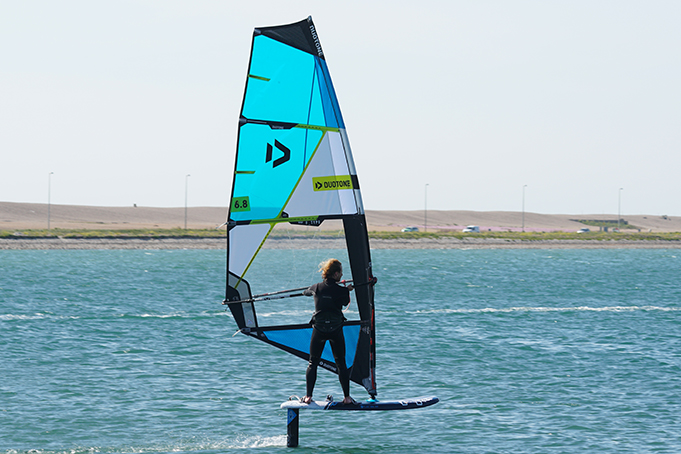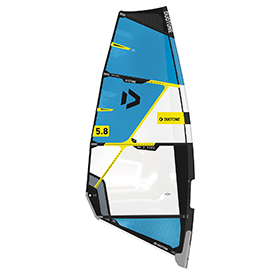
DUOTONE F_TYPE 6.8M 2019 TEST REVIEW
DUOTONE F_TYPE 6.8M 2019 TEST REVIEW
THEY SAY
To get you started as quickly and as easily as possible, and to make sure the fun never ends while on the water, Duotone has introduced the new F_Type – the ideal sail for silently hovering over the water.
WE SAY
Introduced for 2019, the F_Type has just two sizes in the range and is specifically designed for foiling and making the most of the lightest winds. Set on a 430 cm Platinum RDM there are lots of unique features to draw the eye. With just four battens in its structure, it exhibits next to no luff curve and a massive Dacron luff panel from head to tack. There are a couple of removable Switch Soft Cams on the two bottom battens, (akin to the split cams of old), for improved response in light airs. Rigging the sail and fixing the cams in place certainly isn’t as easy as the brand’s fabled Hyper Cam, but with minimal downhaul and outhaul, they can be pushed on, closing the zips and tensioning the battens through the retro cleats to ensure they sit in place as the rest of the tension is applied. With a long gap between the main batten and foot batten, a low-cut foot shape, convex trailing edge outline and minimal looseness in the leech, the F_Type is a long way removed from a contemporary freeride sail, but would the extra performance capacity as a result be noticeable?
Used in light winds and with minimal downhaul, the F_Type is incredibly light and easy in the hands at rest, the centre of effort high yet relatively far back in the draft, providing balance through both hands. The innate softness and geometry of the F_Type make it incredibly successful in translating the smallest gust into usable energy. Pumping the sail is easy, the reduced luff curve enabling the soft mast to flex and spring back into place, whilst the distance between the lower battens provides extra room for movement. The large Dacron luff panel deepens the sail’s lungs, uninhibited by the play in the soft cams, and the extended foot and lower leech panels provide positive feedback whilst pumping, reducing the chance of over-sheeting. It all adds up to a pretty impressive bottom end performance, injecting power and energy early so that the rider can shift their weight back and pump the foil too.
Once planing, the F_Type’s natural stance is upright and easy, the high centre of effort pulling the rider over the board. Supremely light and manageable in the hands, it is also efficient – the set back profile, tight leech and low foot providing plenty of balanced feedback for the rider to maintain their stance and glide through prolonged lulls. In the Duotone blurb, it is suggested to remove the cams entirely for improved handling. For playful manoeuvring, ducking and diving around the rolling swell of a coastal arena … perhaps. But for use in the harbour there really wasn’t the need – the sail remaining light and balanced, inspiring the rider to enter carving transitions positively, whilst the cams rotate in a soft forgiving manner. As the wind increased, we did apply more downhaul (beyond the single VTS marker in the upper panel) to discover its limit. And whilst it wasn’t going to win any drag races (for racing performance look to the newly released Warp_Foil of PWA stardom), the F_Type certainly didn’t present the handling issues envisaged. Ease the sail out through the back hand and the induced profile simply lets the extra energy pass through, blessing the rider with the time and control to reengage whenever they desire.
Other sails in this test:

